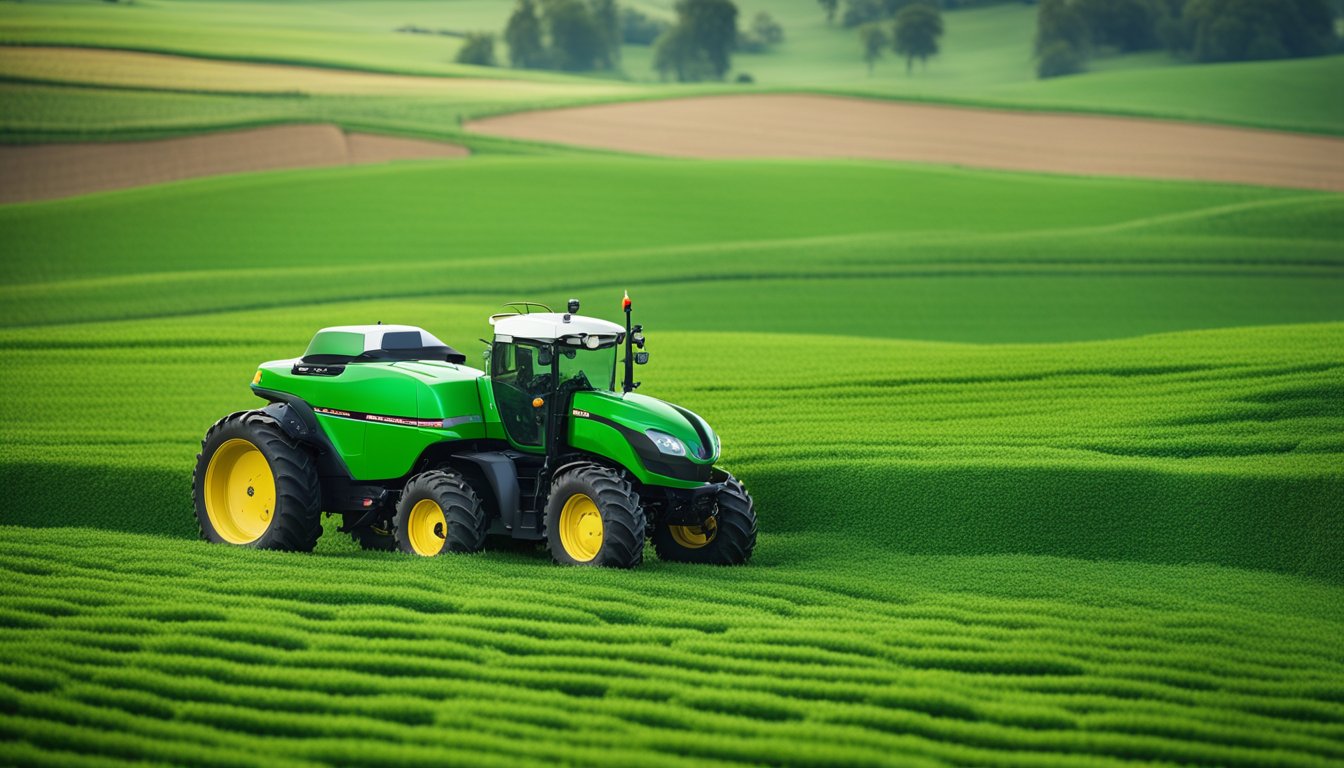Late updated: 10 Jan 2025 14:01
Written by: Oliver Bennett
Understanding AI's Role in UK Rural Connectivity Solutions: Enhancing Remote Access and Infrastructure
Artificial Intelligence (AI) is transforming rural connectivity in the UK, bridging the digital divide that has long isolated these communities. The integration of AI technologies promises not only to enhance connectivity but also to drive economic growth and sustainability, providing new opportunities for innovation and development. AI innovations such as smart technology and the Internet of Things are enhancing broadband access and transforming essential sectors like healthcare and agriculture.

As AI continues to evolve, it offers tailored solutions that meet the unique needs of rural landscapes. From increasing the efficiency of agricultural practices to improving public service delivery, AI is empowering rural areas with tools that were once out of reach. By doing so, it opens pathways for educational opportunities and enhances daily life for residents across the UK.
The potential for AI to reshape rural economies cannot be underestimated. As more Small and Medium Enterprises (SMEs) in rural areas adopt AI, we're seeing higher employment rates and increased turnover supporting economic stability. This shift not only bolsters individual businesses but also contributes to the broader ambition of achieving digital inclusivity across the country.
Key Takeaways
- AI enhances rural connectivity and economic growth.
- AI transforms agriculture and public services.
- SMEs adopting AI experience higher growth.
AI-Driven Connectivity in Rural Landscapes
In the realm of rural UK, AI is pivotal in transforming connectivity. Its influence spans reducing the digital divide, driving economic growth, and integrating emerging technologies. Our exploration delves into how these advancements are reshaping rural landscapes.
Bridging the Digital Divide
AI technologies empower rural areas by enhancing access to vital services. Through intelligent systems, we facilitate stable internet connections, which bridge the gap between urban and rural communities. Developing AI-driven networks like 5G and 6G reduces infrastructure costs, making deployment in remote regions economically viable.
Digital literacy is crucial for rural residents. We must focus on training programmes that enable the effective use of smart technology. Such initiatives ensure equitable access to education, healthcare, and public services, fostering community growth.
Emerging Technologies Impacting Connectivity
Innovations such as IoT and cloud computing have revolutionised rural connectivity. AI plays an integral role in managing these systems, optimising network performance, and ensuring data privacy. Smart sensors, powered by AI, can monitor agricultural activities, increasing productivity and promoting sustainable development.
The rise of satellite technology complements terrestrial solutions. It provides reliable connectivity where traditional telecom infrastructure is lacking. Collaborating with AI, these technologies craft an ecosystem that supports not just connectivity but also data management and cyber security.
The Role of AI in Facilitating Economic Growth
AI capabilities hold transformative potential for the economic landscape of rural areas. By harnessing smart technology, we enhance the efficiency of the agricultural sector, reduce operational costs, and mitigate bias in market data analysis. Integrating AI in public services streamlines processes, making resource allocation more efficient.
As connectivity improves, rural businesses can expand beyond local markets. Access to broader consumer bases and enhanced digital platforms increases opportunities for economic growth. Furthermore, AI-driven systems support sustainable development practices, aligning economic advances with environmental stewardship.
In summary, AI reshapes rural landscapes, closing digital divides, advancing technology, and stimulating economies. Our efforts to integrate these systems will ensure lasting connectivity and development in rural regions.
AI in Agriculture: Revolutionising Farming Practices

In the agricultural sector, the integration of artificial intelligence is leading to significant changes. Precision agriculture, sustainable practices, and innovative technologies are reshaping how farmers optimise resources and address food security challenges.
Precision Agriculture: From Crop Monitoring to Resource Optimisation
AI-driven precision agriculture allows us to increase farming efficiency by using data to monitor and manage crops. Drones and sensors gather real-time data on soil health, plant growth, and weather patterns. This information supports precision farming decisions, such as targeted irrigation and fertilisation, maximising crop yields while minimising waste.
With predictive analytics, we can foresee weather changes, helping farmers to plan their activities better. The adoption of robotics and machine learning also contributes to resource optimisation, reducing labour costs and environmental impact. However, there are challenges in technology adoption, primarily due to the need for infrastructure and training.
Sustainable Agricultural Practices and Food Security
Sustainable farming practices aided by AI are crucial to addressing climate change and meeting global food demand. By implementing data-driven farming, we can ensure the efficient use of water and energy resources. AI technologies, such as digital twins, simulate and optimise agricultural operations for better decision-making.
Utilising renewable energy sources can decrease the carbon footprint of farming activities. Smart farming techniques support biodiversity and ecosystem conservation, essential for long-term sustainability. By balancing resource use with output, we contribute to improving both food security and agricultural sustainability.
Innovation and Challenges in Agricultural Technology
AI and IoT devices are fostering innovation in agricultural technology, driving advancements in irrigation systems, soil analysis, and smart farming solutions. In remote areas, AI can enhance connectivity, allowing for the widespread use of these technologies.
Big data analytics enables the collection and processing of vast amounts of information, facilitating informed decision-making. Despite these advancements, there are challenges, particularly concerning data privacy and economic barriers to technology access. Engaging communities and ensuring fair data use are vital for overcoming these obstacles.
Through collaboration, we can maximise AI's potential to revolutionise agriculture, ensuring efficient, sustainable, and resilient farming practices.
Frequently Asked Questions

AI plays a significant role in elevating rural connectivity across the UK by enhancing broadband access, refining network infrastructure, and ensuring efficient network maintenance. Despite challenges, these technological advancements drive strategic planning and respond to connectivity demands in less urban regions.
How is artificial intelligence enhancing broadband access in rural areas of the UK?
AI-driven solutions, such as predictive analytics and smart algorithms, are facilitating faster and more reliable broadband connections in rural UK. By optimising server allocation and traffic routing, AI maximises the use of available resources to bridge the digital divide experienced by these communities.
What are the primary challenges that AI must overcome to improve connectivity in UK's countryside?
AI faces significant hurdles, including inconsistent infrastructure, limited availability of high-quality data, and the need for tailored solutions suited to diverse rural landscapes. We must address these challenges to ensure reliable connectivity improvements that are scalable and sustainable.
In what ways can machine learning optimise network infrastructure to benefit rural communities?
Machine learning can enhance the efficiency of existing networks by predicting peak usage times and dynamically allocating bandwidth. By intelligently managing resources, these systems ensure consistent connectivity even in areas with fluctuating demand, ultimately benefiting users and service providers alike.
How is AI being utilised to forecast connectivity demand in less urban regions of the UK?
AI systems employ data analytics to forecast demand patterns, allowing service providers to pre-emptively adjust infrastructure deployments. By analysing historical and real-time data, these models provide predictive insights into when and where increased connectivity resources are needed most, ensuring service reliability.
What role does artificial intelligence play in the maintenance and monitoring of rural networks?
AI powers advanced monitoring tools that can detect and diagnose network faults before they escalate into major issues. Using machine learning algorithms, we can perform predictive maintenance, which reduces downtime and minimises the long-term costs associated with network failures in rural areas.
How does AI contribute to the strategic planning of rural network expansion in the UK?
Through geospatial analysis and performance evaluation, AI assists in identifying priority areas for expansion. By modelling potential growth scenarios, AI provides data-driven insights into the most effective strategies for enhancing rural connectivity, ensuring resources are allocated efficiently and strategically.
